Operations Management Implementation Review: Toyota Motor Corporation
VerifiedAdded on 2021/02/20
|17
|4529
|57
Report
AI Summary
This report provides a comprehensive analysis of Toyota Motor Corporation's operations management. It begins with an introduction to operations management and its significance in achieving organizational goals. The report then critiques the implementation of operations management principles within Toyota, followed by the development of a continuous improvement plan. This plan incorporates concepts such as the PDCA cycle and Kaizen, along with strategies like Just-in-Time, automation, and maritime transport to enhance efficiency and reduce costs. The report also applies the project life cycle to a case study involving a leisure center expansion, producing necessary documents for project completion. Finally, it reviews and critiques the effectiveness of the project life cycle using relevant models and theories, providing a detailed evaluation of Toyota's operational strategies.

Paraphrase This Document
Need a fresh take? Get an instant paraphrase of this document with our AI Paraphraser
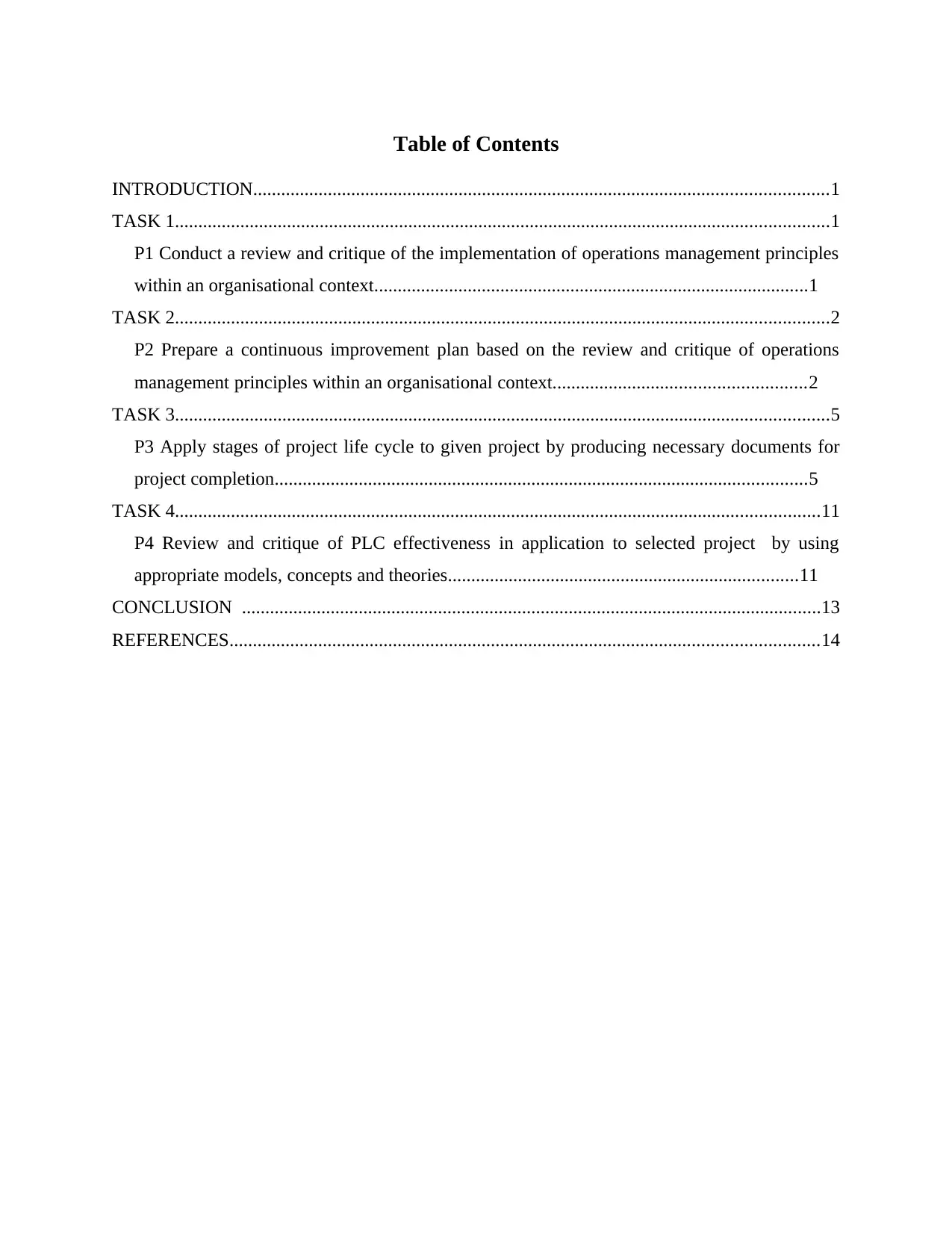
Table of Contents
INTRODUCTION...........................................................................................................................1
TASK 1............................................................................................................................................1
P1 Conduct a review and critique of the implementation of operations management principles
within an organisational context.............................................................................................1
TASK 2............................................................................................................................................2
P2 Prepare a continuous improvement plan based on the review and critique of operations
management principles within an organisational context......................................................2
TASK 3............................................................................................................................................5
P3 Apply stages of project life cycle to given project by producing necessary documents for
project completion..................................................................................................................5
TASK 4..........................................................................................................................................11
P4 Review and critique of PLC effectiveness in application to selected project by using
appropriate models, concepts and theories...........................................................................11
CONCLUSION ............................................................................................................................13
REFERENCES..............................................................................................................................14
INTRODUCTION...........................................................................................................................1
TASK 1............................................................................................................................................1
P1 Conduct a review and critique of the implementation of operations management principles
within an organisational context.............................................................................................1
TASK 2............................................................................................................................................2
P2 Prepare a continuous improvement plan based on the review and critique of operations
management principles within an organisational context......................................................2
TASK 3............................................................................................................................................5
P3 Apply stages of project life cycle to given project by producing necessary documents for
project completion..................................................................................................................5
TASK 4..........................................................................................................................................11
P4 Review and critique of PLC effectiveness in application to selected project by using
appropriate models, concepts and theories...........................................................................11
CONCLUSION ............................................................................................................................13
REFERENCES..............................................................................................................................14
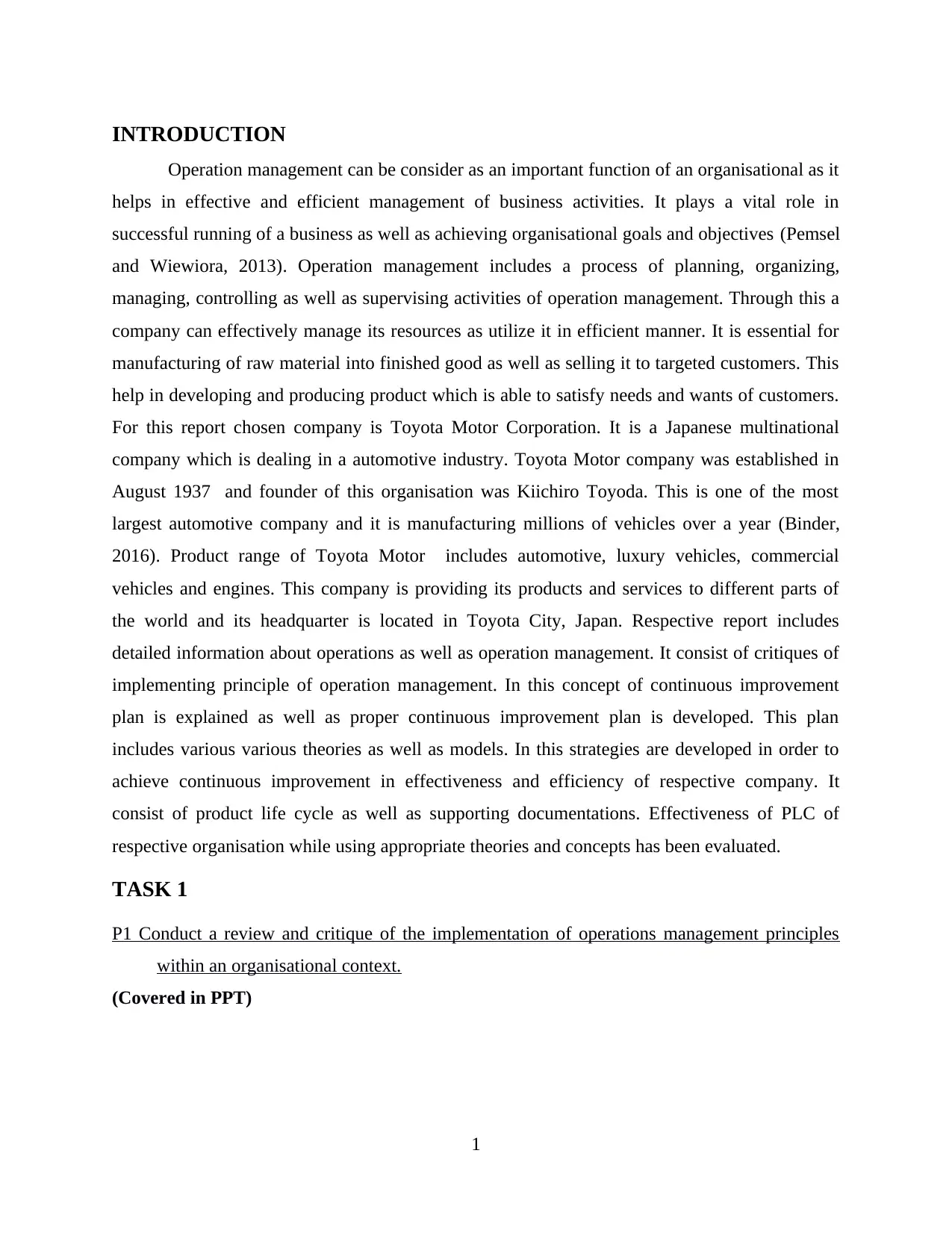
INTRODUCTION
Operation management can be consider as an important function of an organisational as it
helps in effective and efficient management of business activities. It plays a vital role in
successful running of a business as well as achieving organisational goals and objectives (Pemsel
and Wiewiora, 2013). Operation management includes a process of planning, organizing,
managing, controlling as well as supervising activities of operation management. Through this a
company can effectively manage its resources as utilize it in efficient manner. It is essential for
manufacturing of raw material into finished good as well as selling it to targeted customers. This
help in developing and producing product which is able to satisfy needs and wants of customers.
For this report chosen company is Toyota Motor Corporation. It is a Japanese multinational
company which is dealing in a automotive industry. Toyota Motor company was established in
August 1937 and founder of this organisation was Kiichiro Toyoda. This is one of the most
largest automotive company and it is manufacturing millions of vehicles over a year (Binder,
2016). Product range of Toyota Motor includes automotive, luxury vehicles, commercial
vehicles and engines. This company is providing its products and services to different parts of
the world and its headquarter is located in Toyota City, Japan. Respective report includes
detailed information about operations as well as operation management. It consist of critiques of
implementing principle of operation management. In this concept of continuous improvement
plan is explained as well as proper continuous improvement plan is developed. This plan
includes various various theories as well as models. In this strategies are developed in order to
achieve continuous improvement in effectiveness and efficiency of respective company. It
consist of product life cycle as well as supporting documentations. Effectiveness of PLC of
respective organisation while using appropriate theories and concepts has been evaluated.
TASK 1
P1 Conduct a review and critique of the implementation of operations management principles
within an organisational context.
(Covered in PPT)
1
Operation management can be consider as an important function of an organisational as it
helps in effective and efficient management of business activities. It plays a vital role in
successful running of a business as well as achieving organisational goals and objectives (Pemsel
and Wiewiora, 2013). Operation management includes a process of planning, organizing,
managing, controlling as well as supervising activities of operation management. Through this a
company can effectively manage its resources as utilize it in efficient manner. It is essential for
manufacturing of raw material into finished good as well as selling it to targeted customers. This
help in developing and producing product which is able to satisfy needs and wants of customers.
For this report chosen company is Toyota Motor Corporation. It is a Japanese multinational
company which is dealing in a automotive industry. Toyota Motor company was established in
August 1937 and founder of this organisation was Kiichiro Toyoda. This is one of the most
largest automotive company and it is manufacturing millions of vehicles over a year (Binder,
2016). Product range of Toyota Motor includes automotive, luxury vehicles, commercial
vehicles and engines. This company is providing its products and services to different parts of
the world and its headquarter is located in Toyota City, Japan. Respective report includes
detailed information about operations as well as operation management. It consist of critiques of
implementing principle of operation management. In this concept of continuous improvement
plan is explained as well as proper continuous improvement plan is developed. This plan
includes various various theories as well as models. In this strategies are developed in order to
achieve continuous improvement in effectiveness and efficiency of respective company. It
consist of product life cycle as well as supporting documentations. Effectiveness of PLC of
respective organisation while using appropriate theories and concepts has been evaluated.
TASK 1
P1 Conduct a review and critique of the implementation of operations management principles
within an organisational context.
(Covered in PPT)
1
⊘ This is a preview!⊘
Do you want full access?
Subscribe today to unlock all pages.

Trusted by 1+ million students worldwide
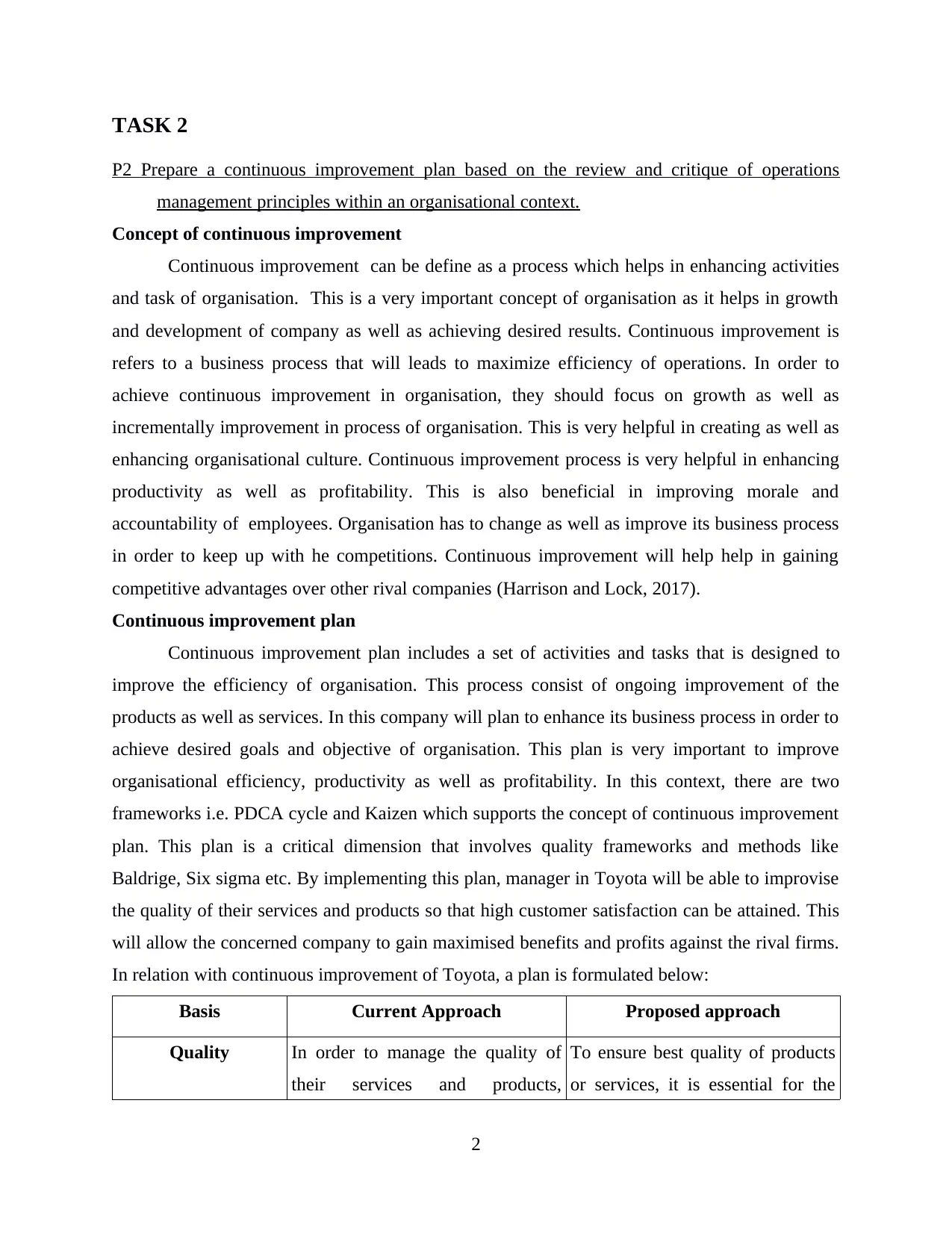
TASK 2
P2 Prepare a continuous improvement plan based on the review and critique of operations
management principles within an organisational context.
Concept of continuous improvement
Continuous improvement can be define as a process which helps in enhancing activities
and task of organisation. This is a very important concept of organisation as it helps in growth
and development of company as well as achieving desired results. Continuous improvement is
refers to a business process that will leads to maximize efficiency of operations. In order to
achieve continuous improvement in organisation, they should focus on growth as well as
incrementally improvement in process of organisation. This is very helpful in creating as well as
enhancing organisational culture. Continuous improvement process is very helpful in enhancing
productivity as well as profitability. This is also beneficial in improving morale and
accountability of employees. Organisation has to change as well as improve its business process
in order to keep up with he competitions. Continuous improvement will help help in gaining
competitive advantages over other rival companies (Harrison and Lock, 2017).
Continuous improvement plan
Continuous improvement plan includes a set of activities and tasks that is designed to
improve the efficiency of organisation. This process consist of ongoing improvement of the
products as well as services. In this company will plan to enhance its business process in order to
achieve desired goals and objective of organisation. This plan is very important to improve
organisational efficiency, productivity as well as profitability. In this context, there are two
frameworks i.e. PDCA cycle and Kaizen which supports the concept of continuous improvement
plan. This plan is a critical dimension that involves quality frameworks and methods like
Baldrige, Six sigma etc. By implementing this plan, manager in Toyota will be able to improvise
the quality of their services and products so that high customer satisfaction can be attained. This
will allow the concerned company to gain maximised benefits and profits against the rival firms.
In relation with continuous improvement of Toyota, a plan is formulated below:
Basis Current Approach Proposed approach
Quality In order to manage the quality of
their services and products,
To ensure best quality of products
or services, it is essential for the
2
P2 Prepare a continuous improvement plan based on the review and critique of operations
management principles within an organisational context.
Concept of continuous improvement
Continuous improvement can be define as a process which helps in enhancing activities
and task of organisation. This is a very important concept of organisation as it helps in growth
and development of company as well as achieving desired results. Continuous improvement is
refers to a business process that will leads to maximize efficiency of operations. In order to
achieve continuous improvement in organisation, they should focus on growth as well as
incrementally improvement in process of organisation. This is very helpful in creating as well as
enhancing organisational culture. Continuous improvement process is very helpful in enhancing
productivity as well as profitability. This is also beneficial in improving morale and
accountability of employees. Organisation has to change as well as improve its business process
in order to keep up with he competitions. Continuous improvement will help help in gaining
competitive advantages over other rival companies (Harrison and Lock, 2017).
Continuous improvement plan
Continuous improvement plan includes a set of activities and tasks that is designed to
improve the efficiency of organisation. This process consist of ongoing improvement of the
products as well as services. In this company will plan to enhance its business process in order to
achieve desired goals and objective of organisation. This plan is very important to improve
organisational efficiency, productivity as well as profitability. In this context, there are two
frameworks i.e. PDCA cycle and Kaizen which supports the concept of continuous improvement
plan. This plan is a critical dimension that involves quality frameworks and methods like
Baldrige, Six sigma etc. By implementing this plan, manager in Toyota will be able to improvise
the quality of their services and products so that high customer satisfaction can be attained. This
will allow the concerned company to gain maximised benefits and profits against the rival firms.
In relation with continuous improvement of Toyota, a plan is formulated below:
Basis Current Approach Proposed approach
Quality In order to manage the quality of
their services and products,
To ensure best quality of products
or services, it is essential for the
2
Paraphrase This Document
Need a fresh take? Get an instant paraphrase of this document with our AI Paraphraser
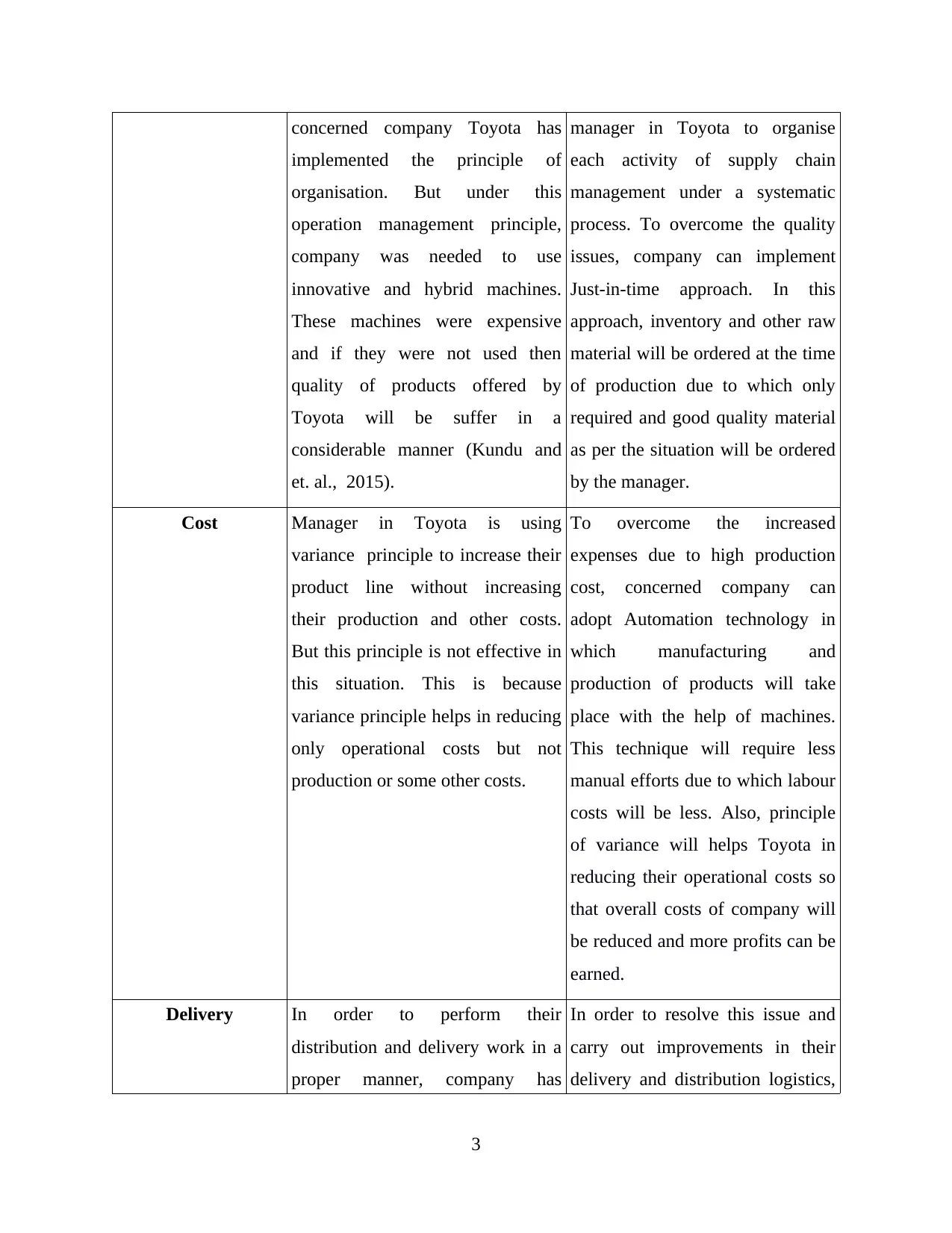
concerned company Toyota has
implemented the principle of
organisation. But under this
operation management principle,
company was needed to use
innovative and hybrid machines.
These machines were expensive
and if they were not used then
quality of products offered by
Toyota will be suffer in a
considerable manner (Kundu and
et. al., 2015).
manager in Toyota to organise
each activity of supply chain
management under a systematic
process. To overcome the quality
issues, company can implement
Just-in-time approach. In this
approach, inventory and other raw
material will be ordered at the time
of production due to which only
required and good quality material
as per the situation will be ordered
by the manager.
Cost Manager in Toyota is using
variance principle to increase their
product line without increasing
their production and other costs.
But this principle is not effective in
this situation. This is because
variance principle helps in reducing
only operational costs but not
production or some other costs.
To overcome the increased
expenses due to high production
cost, concerned company can
adopt Automation technology in
which manufacturing and
production of products will take
place with the help of machines.
This technique will require less
manual efforts due to which labour
costs will be less. Also, principle
of variance will helps Toyota in
reducing their operational costs so
that overall costs of company will
be reduced and more profits can be
earned.
Delivery In order to perform their
distribution and delivery work in a
proper manner, company has
In order to resolve this issue and
carry out improvements in their
delivery and distribution logistics,
3
implemented the principle of
organisation. But under this
operation management principle,
company was needed to use
innovative and hybrid machines.
These machines were expensive
and if they were not used then
quality of products offered by
Toyota will be suffer in a
considerable manner (Kundu and
et. al., 2015).
manager in Toyota to organise
each activity of supply chain
management under a systematic
process. To overcome the quality
issues, company can implement
Just-in-time approach. In this
approach, inventory and other raw
material will be ordered at the time
of production due to which only
required and good quality material
as per the situation will be ordered
by the manager.
Cost Manager in Toyota is using
variance principle to increase their
product line without increasing
their production and other costs.
But this principle is not effective in
this situation. This is because
variance principle helps in reducing
only operational costs but not
production or some other costs.
To overcome the increased
expenses due to high production
cost, concerned company can
adopt Automation technology in
which manufacturing and
production of products will take
place with the help of machines.
This technique will require less
manual efforts due to which labour
costs will be less. Also, principle
of variance will helps Toyota in
reducing their operational costs so
that overall costs of company will
be reduced and more profits can be
earned.
Delivery In order to perform their
distribution and delivery work in a
proper manner, company has
In order to resolve this issue and
carry out improvements in their
delivery and distribution logistics,
3
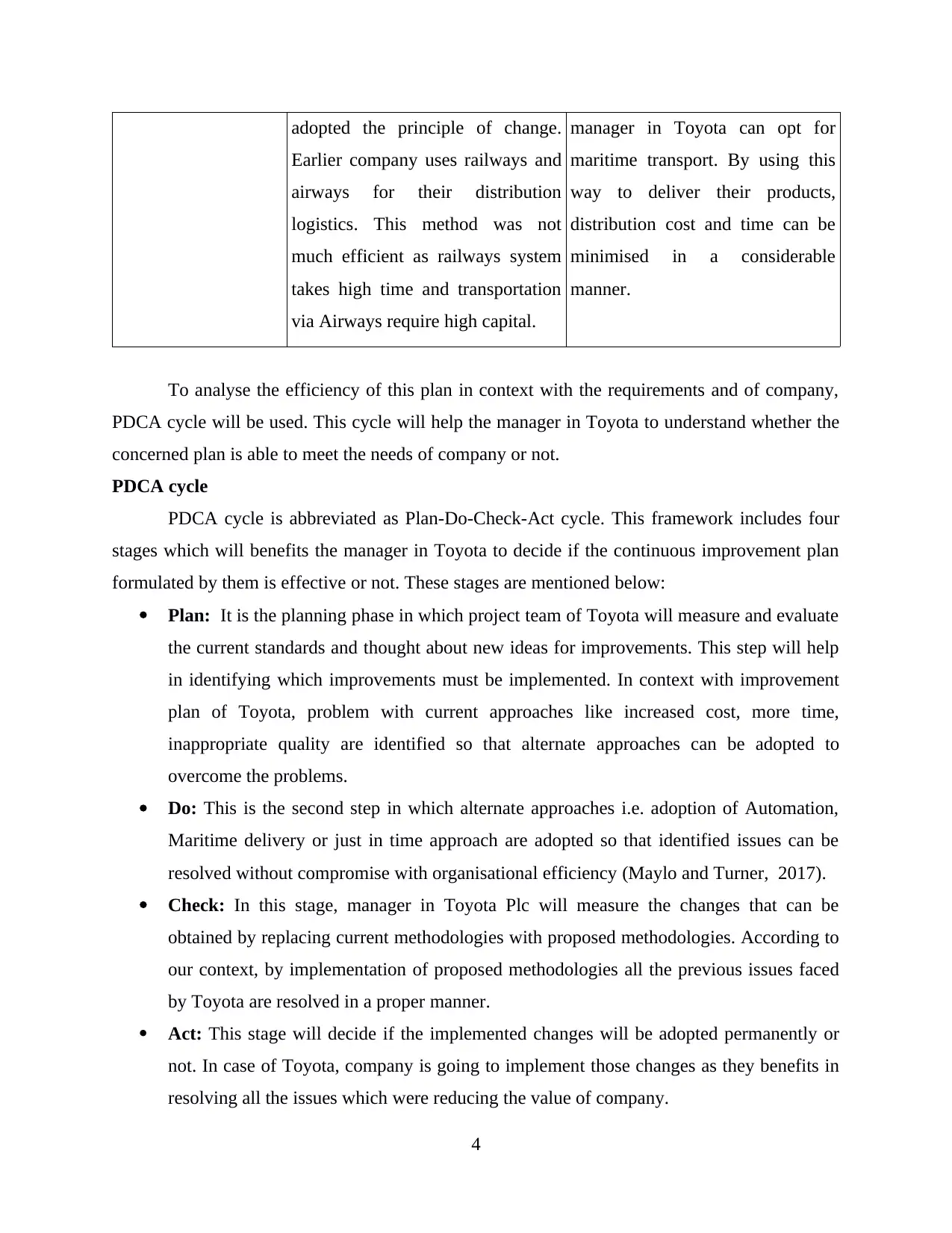
adopted the principle of change.
Earlier company uses railways and
airways for their distribution
logistics. This method was not
much efficient as railways system
takes high time and transportation
via Airways require high capital.
manager in Toyota can opt for
maritime transport. By using this
way to deliver their products,
distribution cost and time can be
minimised in a considerable
manner.
To analyse the efficiency of this plan in context with the requirements and of company,
PDCA cycle will be used. This cycle will help the manager in Toyota to understand whether the
concerned plan is able to meet the needs of company or not.
PDCA cycle
PDCA cycle is abbreviated as Plan-Do-Check-Act cycle. This framework includes four
stages which will benefits the manager in Toyota to decide if the continuous improvement plan
formulated by them is effective or not. These stages are mentioned below:
Plan: It is the planning phase in which project team of Toyota will measure and evaluate
the current standards and thought about new ideas for improvements. This step will help
in identifying which improvements must be implemented. In context with improvement
plan of Toyota, problem with current approaches like increased cost, more time,
inappropriate quality are identified so that alternate approaches can be adopted to
overcome the problems.
Do: This is the second step in which alternate approaches i.e. adoption of Automation,
Maritime delivery or just in time approach are adopted so that identified issues can be
resolved without compromise with organisational efficiency (Maylo and Turner, 2017).
Check: In this stage, manager in Toyota Plc will measure the changes that can be
obtained by replacing current methodologies with proposed methodologies. According to
our context, by implementation of proposed methodologies all the previous issues faced
by Toyota are resolved in a proper manner.
Act: This stage will decide if the implemented changes will be adopted permanently or
not. In case of Toyota, company is going to implement those changes as they benefits in
resolving all the issues which were reducing the value of company.
4
Earlier company uses railways and
airways for their distribution
logistics. This method was not
much efficient as railways system
takes high time and transportation
via Airways require high capital.
manager in Toyota can opt for
maritime transport. By using this
way to deliver their products,
distribution cost and time can be
minimised in a considerable
manner.
To analyse the efficiency of this plan in context with the requirements and of company,
PDCA cycle will be used. This cycle will help the manager in Toyota to understand whether the
concerned plan is able to meet the needs of company or not.
PDCA cycle
PDCA cycle is abbreviated as Plan-Do-Check-Act cycle. This framework includes four
stages which will benefits the manager in Toyota to decide if the continuous improvement plan
formulated by them is effective or not. These stages are mentioned below:
Plan: It is the planning phase in which project team of Toyota will measure and evaluate
the current standards and thought about new ideas for improvements. This step will help
in identifying which improvements must be implemented. In context with improvement
plan of Toyota, problem with current approaches like increased cost, more time,
inappropriate quality are identified so that alternate approaches can be adopted to
overcome the problems.
Do: This is the second step in which alternate approaches i.e. adoption of Automation,
Maritime delivery or just in time approach are adopted so that identified issues can be
resolved without compromise with organisational efficiency (Maylo and Turner, 2017).
Check: In this stage, manager in Toyota Plc will measure the changes that can be
obtained by replacing current methodologies with proposed methodologies. According to
our context, by implementation of proposed methodologies all the previous issues faced
by Toyota are resolved in a proper manner.
Act: This stage will decide if the implemented changes will be adopted permanently or
not. In case of Toyota, company is going to implement those changes as they benefits in
resolving all the issues which were reducing the value of company.
4
⊘ This is a preview!⊘
Do you want full access?
Subscribe today to unlock all pages.

Trusted by 1+ million students worldwide
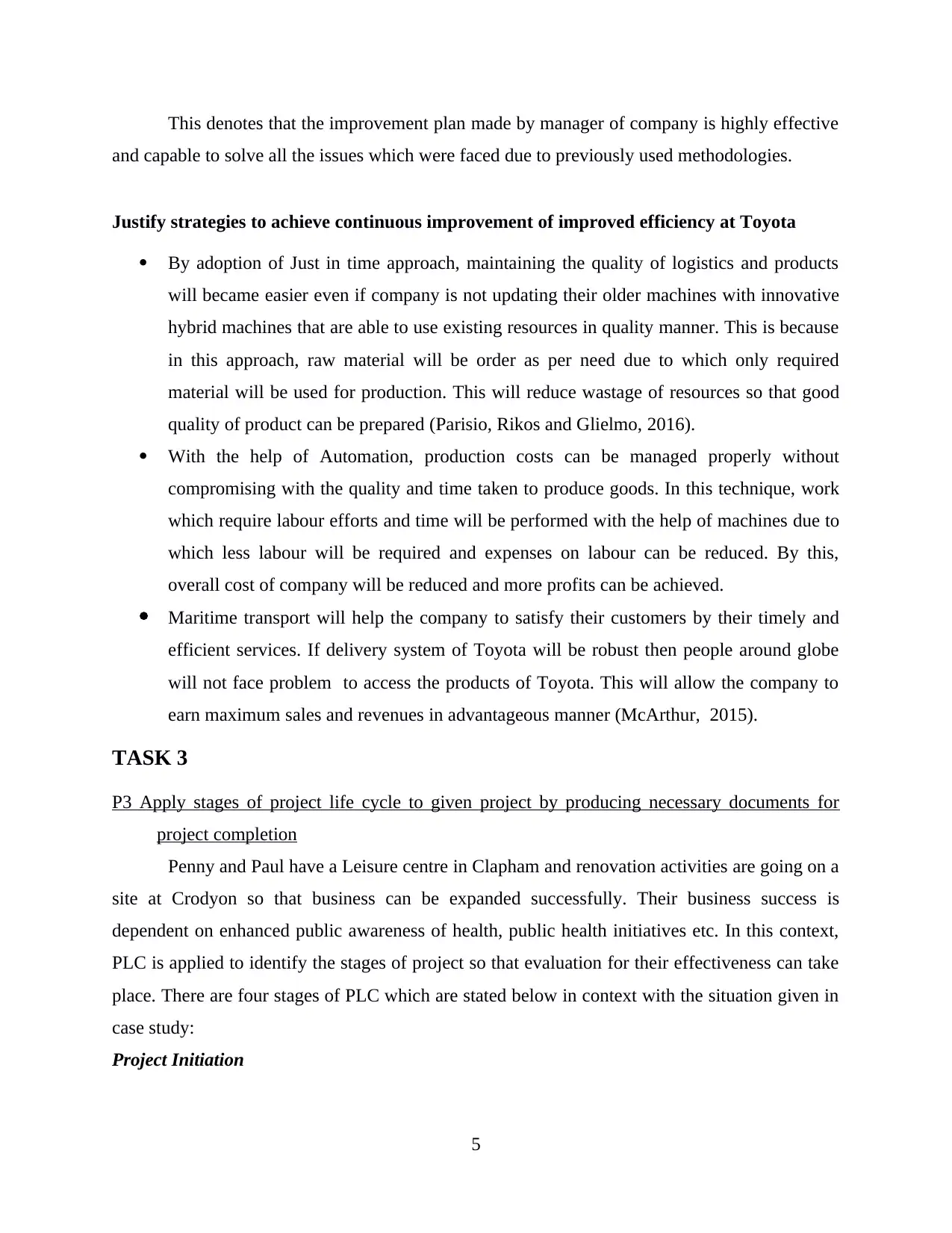
This denotes that the improvement plan made by manager of company is highly effective
and capable to solve all the issues which were faced due to previously used methodologies.
Justify strategies to achieve continuous improvement of improved efficiency at Toyota
By adoption of Just in time approach, maintaining the quality of logistics and products
will became easier even if company is not updating their older machines with innovative
hybrid machines that are able to use existing resources in quality manner. This is because
in this approach, raw material will be order as per need due to which only required
material will be used for production. This will reduce wastage of resources so that good
quality of product can be prepared (Parisio, Rikos and Glielmo, 2016).
With the help of Automation, production costs can be managed properly without
compromising with the quality and time taken to produce goods. In this technique, work
which require labour efforts and time will be performed with the help of machines due to
which less labour will be required and expenses on labour can be reduced. By this,
overall cost of company will be reduced and more profits can be achieved.
Maritime transport will help the company to satisfy their customers by their timely and
efficient services. If delivery system of Toyota will be robust then people around globe
will not face problem to access the products of Toyota. This will allow the company to
earn maximum sales and revenues in advantageous manner (McArthur, 2015).
TASK 3
P3 Apply stages of project life cycle to given project by producing necessary documents for
project completion
Penny and Paul have a Leisure centre in Clapham and renovation activities are going on a
site at Crodyon so that business can be expanded successfully. Their business success is
dependent on enhanced public awareness of health, public health initiatives etc. In this context,
PLC is applied to identify the stages of project so that evaluation for their effectiveness can take
place. There are four stages of PLC which are stated below in context with the situation given in
case study:
Project Initiation
5
and capable to solve all the issues which were faced due to previously used methodologies.
Justify strategies to achieve continuous improvement of improved efficiency at Toyota
By adoption of Just in time approach, maintaining the quality of logistics and products
will became easier even if company is not updating their older machines with innovative
hybrid machines that are able to use existing resources in quality manner. This is because
in this approach, raw material will be order as per need due to which only required
material will be used for production. This will reduce wastage of resources so that good
quality of product can be prepared (Parisio, Rikos and Glielmo, 2016).
With the help of Automation, production costs can be managed properly without
compromising with the quality and time taken to produce goods. In this technique, work
which require labour efforts and time will be performed with the help of machines due to
which less labour will be required and expenses on labour can be reduced. By this,
overall cost of company will be reduced and more profits can be achieved.
Maritime transport will help the company to satisfy their customers by their timely and
efficient services. If delivery system of Toyota will be robust then people around globe
will not face problem to access the products of Toyota. This will allow the company to
earn maximum sales and revenues in advantageous manner (McArthur, 2015).
TASK 3
P3 Apply stages of project life cycle to given project by producing necessary documents for
project completion
Penny and Paul have a Leisure centre in Clapham and renovation activities are going on a
site at Crodyon so that business can be expanded successfully. Their business success is
dependent on enhanced public awareness of health, public health initiatives etc. In this context,
PLC is applied to identify the stages of project so that evaluation for their effectiveness can take
place. There are four stages of PLC which are stated below in context with the situation given in
case study:
Project Initiation
5
Paraphrase This Document
Need a fresh take? Get an instant paraphrase of this document with our AI Paraphraser
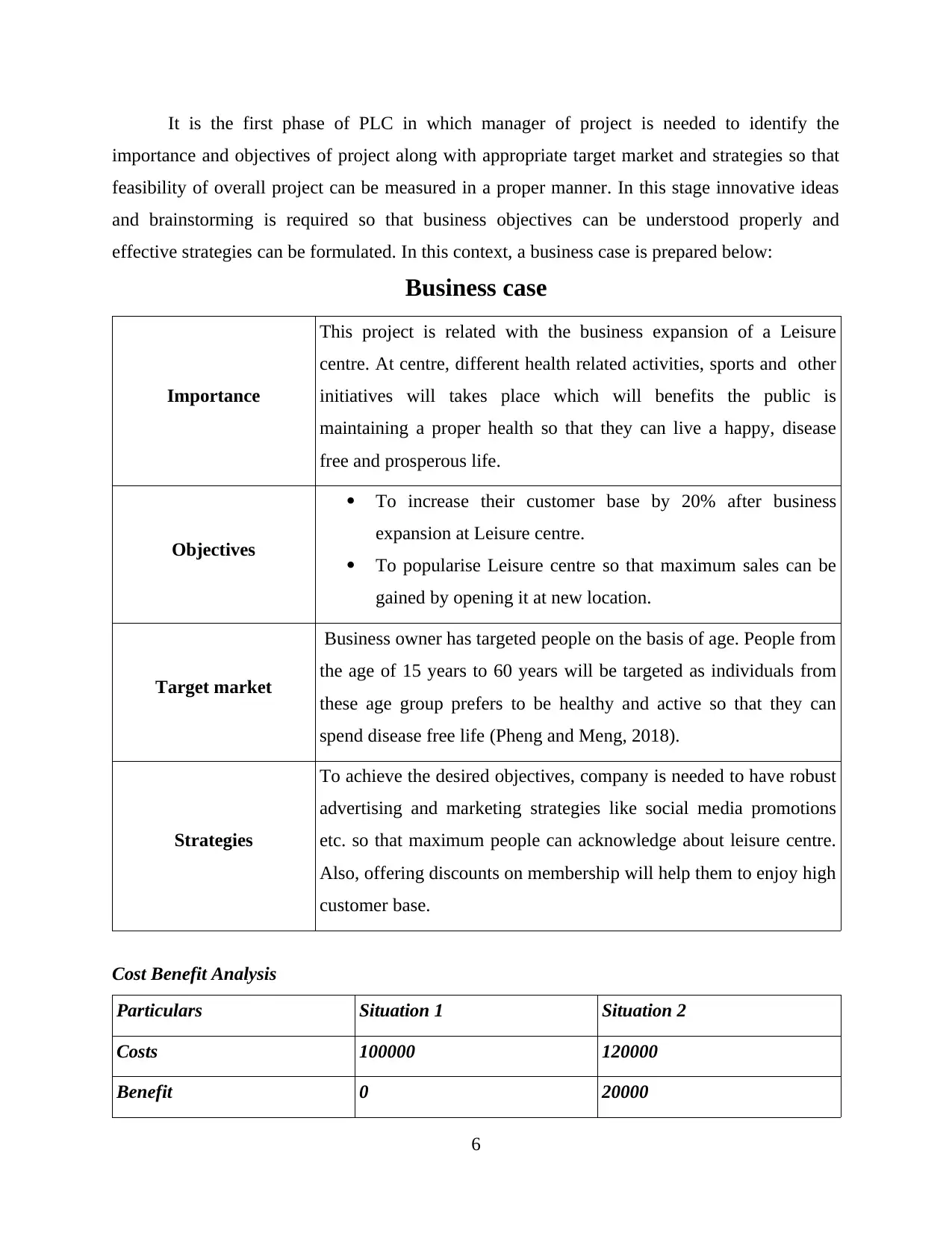
It is the first phase of PLC in which manager of project is needed to identify the
importance and objectives of project along with appropriate target market and strategies so that
feasibility of overall project can be measured in a proper manner. In this stage innovative ideas
and brainstorming is required so that business objectives can be understood properly and
effective strategies can be formulated. In this context, a business case is prepared below:
Business case
Importance
This project is related with the business expansion of a Leisure
centre. At centre, different health related activities, sports and other
initiatives will takes place which will benefits the public is
maintaining a proper health so that they can live a happy, disease
free and prosperous life.
Objectives
To increase their customer base by 20% after business
expansion at Leisure centre.
To popularise Leisure centre so that maximum sales can be
gained by opening it at new location.
Target market
Business owner has targeted people on the basis of age. People from
the age of 15 years to 60 years will be targeted as individuals from
these age group prefers to be healthy and active so that they can
spend disease free life (Pheng and Meng, 2018).
Strategies
To achieve the desired objectives, company is needed to have robust
advertising and marketing strategies like social media promotions
etc. so that maximum people can acknowledge about leisure centre.
Also, offering discounts on membership will help them to enjoy high
customer base.
Cost Benefit Analysis
Particulars Situation 1 Situation 2
Costs 100000 120000
Benefit 0 20000
6
importance and objectives of project along with appropriate target market and strategies so that
feasibility of overall project can be measured in a proper manner. In this stage innovative ideas
and brainstorming is required so that business objectives can be understood properly and
effective strategies can be formulated. In this context, a business case is prepared below:
Business case
Importance
This project is related with the business expansion of a Leisure
centre. At centre, different health related activities, sports and other
initiatives will takes place which will benefits the public is
maintaining a proper health so that they can live a happy, disease
free and prosperous life.
Objectives
To increase their customer base by 20% after business
expansion at Leisure centre.
To popularise Leisure centre so that maximum sales can be
gained by opening it at new location.
Target market
Business owner has targeted people on the basis of age. People from
the age of 15 years to 60 years will be targeted as individuals from
these age group prefers to be healthy and active so that they can
spend disease free life (Pheng and Meng, 2018).
Strategies
To achieve the desired objectives, company is needed to have robust
advertising and marketing strategies like social media promotions
etc. so that maximum people can acknowledge about leisure centre.
Also, offering discounts on membership will help them to enjoy high
customer base.
Cost Benefit Analysis
Particulars Situation 1 Situation 2
Costs 100000 120000
Benefit 0 20000
6
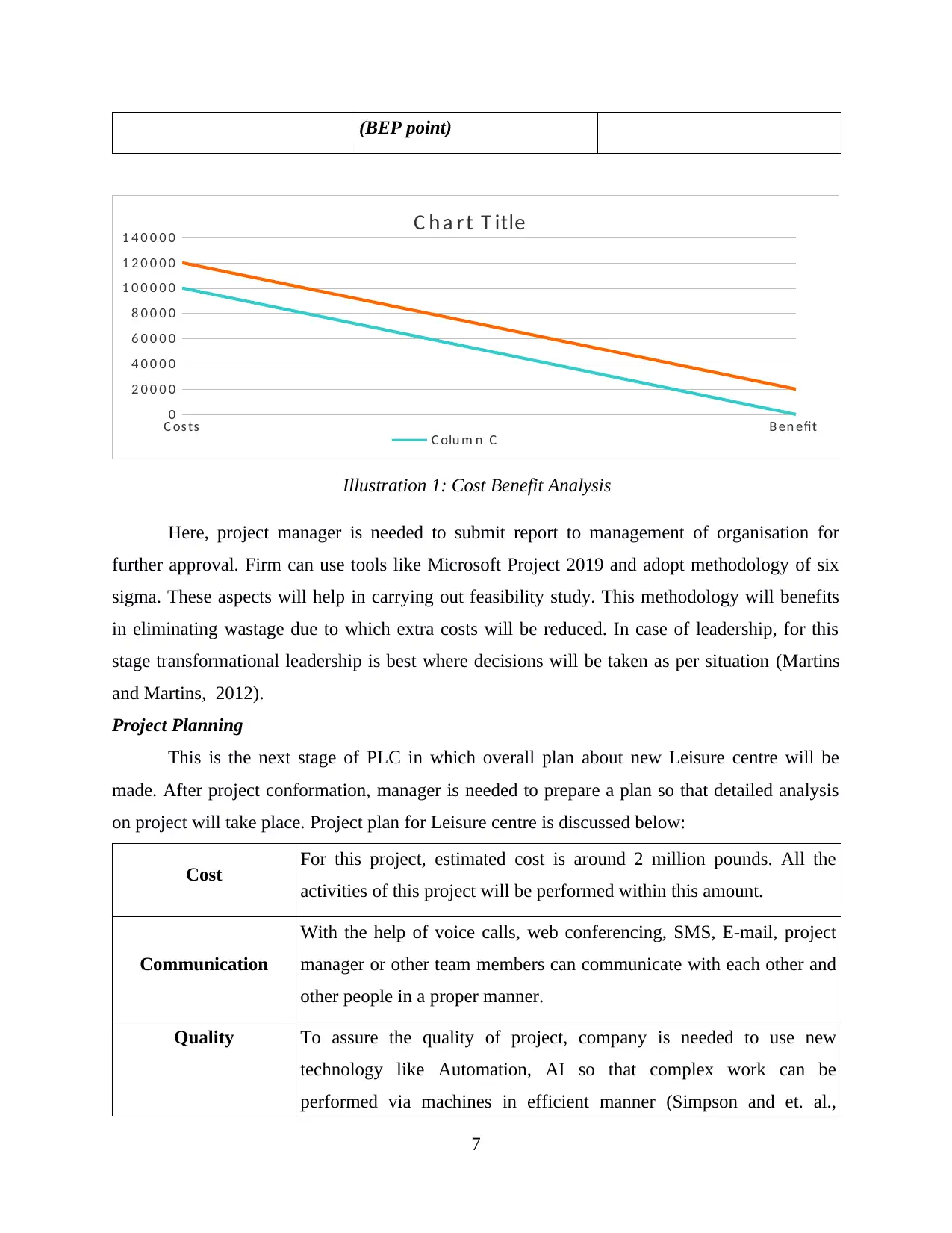
(BEP point)
C os ts B en efit
0
2 0 0 0 0
4 0 0 0 0
6 0 0 0 0
8 0 0 0 0
1 0 0 0 0 0
1 2 0 0 0 0
1 4 0 0 0 0 C h a rt T itle
C olu m n C
Illustration 1: Cost Benefit Analysis
Here, project manager is needed to submit report to management of organisation for
further approval. Firm can use tools like Microsoft Project 2019 and adopt methodology of six
sigma. These aspects will help in carrying out feasibility study. This methodology will benefits
in eliminating wastage due to which extra costs will be reduced. In case of leadership, for this
stage transformational leadership is best where decisions will be taken as per situation (Martins
and Martins, 2012).
Project Planning
This is the next stage of PLC in which overall plan about new Leisure centre will be
made. After project conformation, manager is needed to prepare a plan so that detailed analysis
on project will take place. Project plan for Leisure centre is discussed below:
Cost For this project, estimated cost is around 2 million pounds. All the
activities of this project will be performed within this amount.
Communication
With the help of voice calls, web conferencing, SMS, E-mail, project
manager or other team members can communicate with each other and
other people in a proper manner.
Quality To assure the quality of project, company is needed to use new
technology like Automation, AI so that complex work can be
performed via machines in efficient manner (Simpson and et. al.,
7
C os ts B en efit
0
2 0 0 0 0
4 0 0 0 0
6 0 0 0 0
8 0 0 0 0
1 0 0 0 0 0
1 2 0 0 0 0
1 4 0 0 0 0 C h a rt T itle
C olu m n C
Illustration 1: Cost Benefit Analysis
Here, project manager is needed to submit report to management of organisation for
further approval. Firm can use tools like Microsoft Project 2019 and adopt methodology of six
sigma. These aspects will help in carrying out feasibility study. This methodology will benefits
in eliminating wastage due to which extra costs will be reduced. In case of leadership, for this
stage transformational leadership is best where decisions will be taken as per situation (Martins
and Martins, 2012).
Project Planning
This is the next stage of PLC in which overall plan about new Leisure centre will be
made. After project conformation, manager is needed to prepare a plan so that detailed analysis
on project will take place. Project plan for Leisure centre is discussed below:
Cost For this project, estimated cost is around 2 million pounds. All the
activities of this project will be performed within this amount.
Communication
With the help of voice calls, web conferencing, SMS, E-mail, project
manager or other team members can communicate with each other and
other people in a proper manner.
Quality To assure the quality of project, company is needed to use new
technology like Automation, AI so that complex work can be
performed via machines in efficient manner (Simpson and et. al.,
7
⊘ This is a preview!⊘
Do you want full access?
Subscribe today to unlock all pages.

Trusted by 1+ million students worldwide
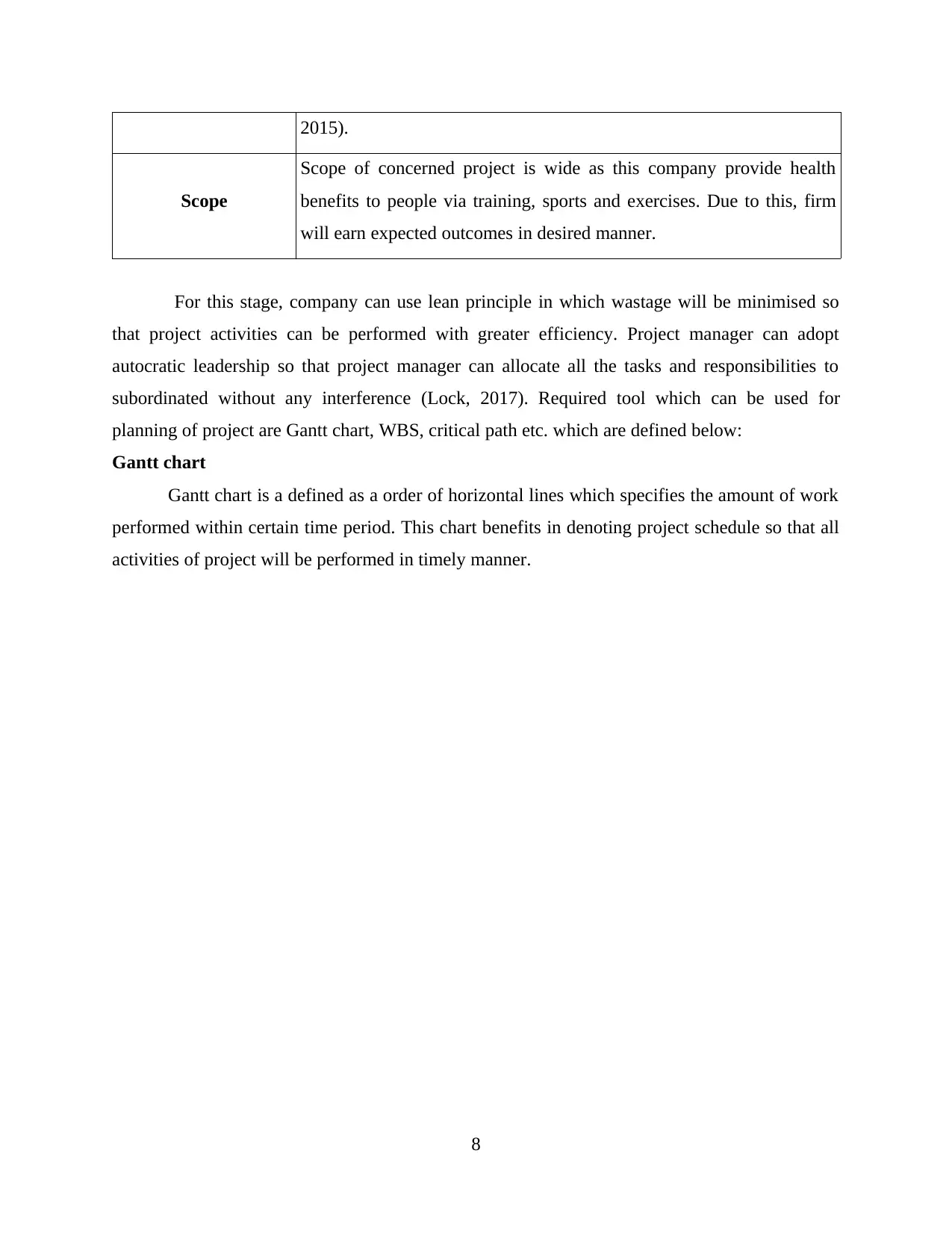
2015).
Scope
Scope of concerned project is wide as this company provide health
benefits to people via training, sports and exercises. Due to this, firm
will earn expected outcomes in desired manner.
For this stage, company can use lean principle in which wastage will be minimised so
that project activities can be performed with greater efficiency. Project manager can adopt
autocratic leadership so that project manager can allocate all the tasks and responsibilities to
subordinated without any interference (Lock, 2017). Required tool which can be used for
planning of project are Gantt chart, WBS, critical path etc. which are defined below:
Gantt chart
Gantt chart is a defined as a order of horizontal lines which specifies the amount of work
performed within certain time period. This chart benefits in denoting project schedule so that all
activities of project will be performed in timely manner.
8
Scope
Scope of concerned project is wide as this company provide health
benefits to people via training, sports and exercises. Due to this, firm
will earn expected outcomes in desired manner.
For this stage, company can use lean principle in which wastage will be minimised so
that project activities can be performed with greater efficiency. Project manager can adopt
autocratic leadership so that project manager can allocate all the tasks and responsibilities to
subordinated without any interference (Lock, 2017). Required tool which can be used for
planning of project are Gantt chart, WBS, critical path etc. which are defined below:
Gantt chart
Gantt chart is a defined as a order of horizontal lines which specifies the amount of work
performed within certain time period. This chart benefits in denoting project schedule so that all
activities of project will be performed in timely manner.
8
Paraphrase This Document
Need a fresh take? Get an instant paraphrase of this document with our AI Paraphraser
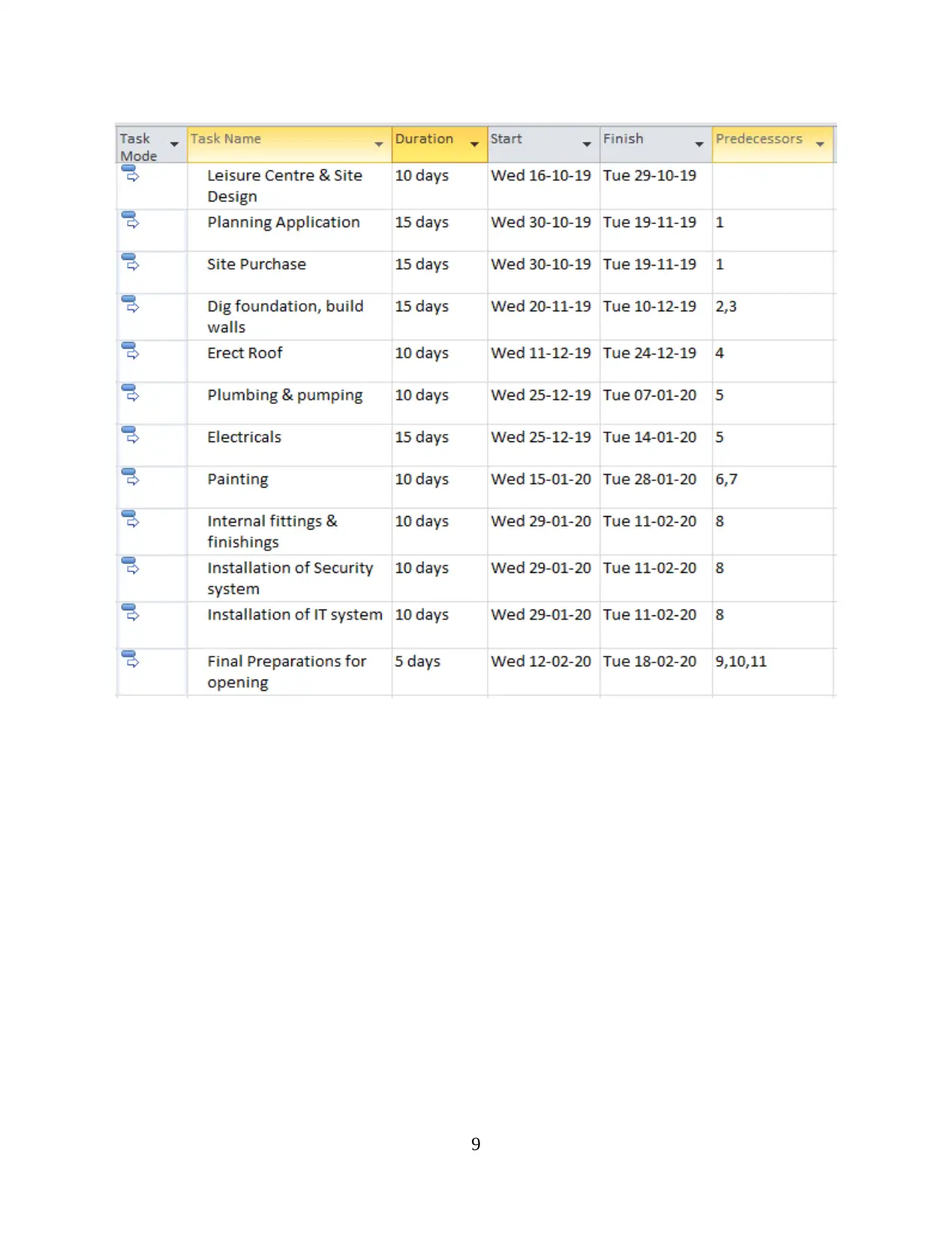
9
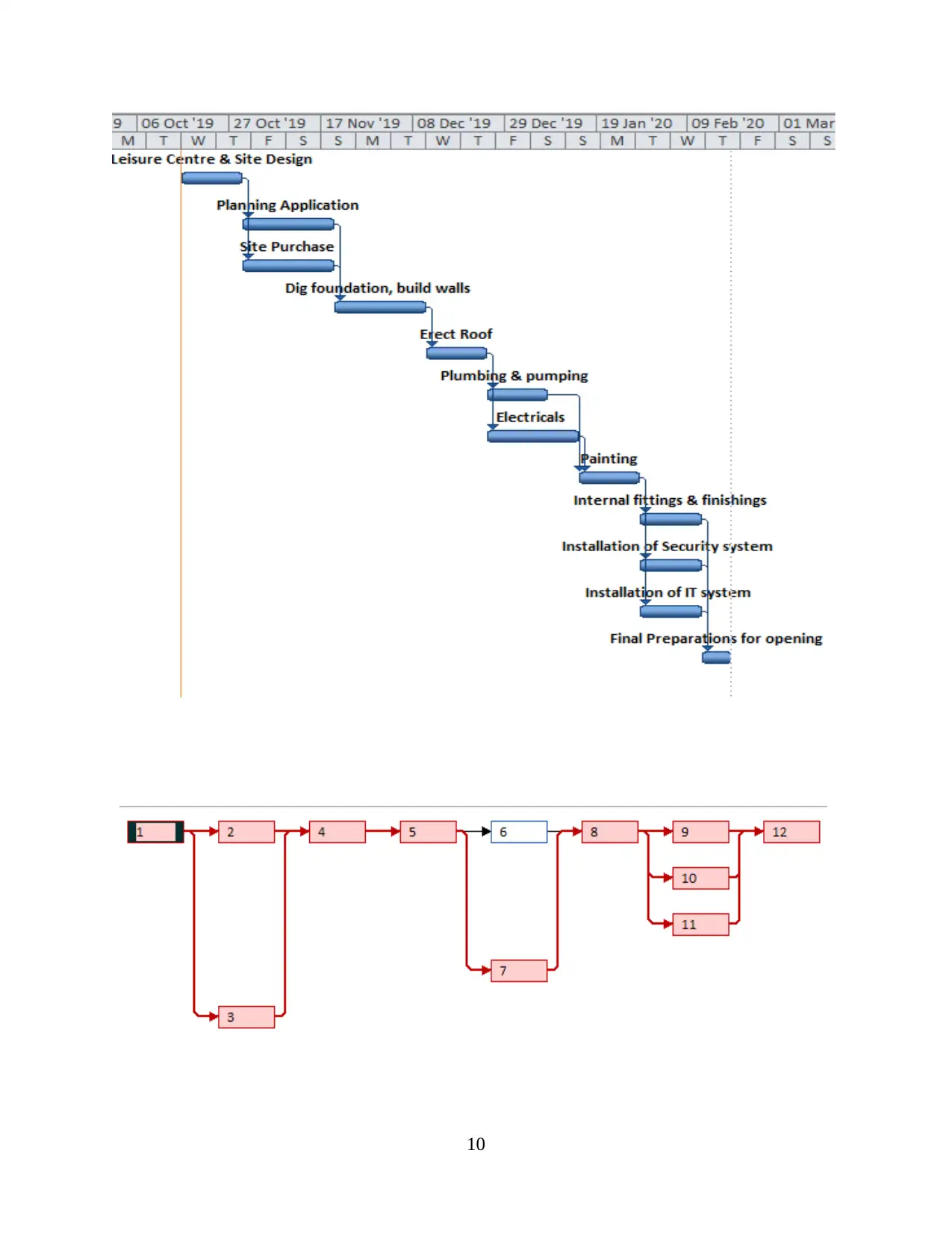
10
⊘ This is a preview!⊘
Do you want full access?
Subscribe today to unlock all pages.

Trusted by 1+ million students worldwide
1 out of 17
Related Documents
Your All-in-One AI-Powered Toolkit for Academic Success.
+13062052269
info@desklib.com
Available 24*7 on WhatsApp / Email
![[object Object]](/_next/static/media/star-bottom.7253800d.svg)
Unlock your academic potential
Copyright © 2020–2025 A2Z Services. All Rights Reserved. Developed and managed by ZUCOL.




